Elderly Care and Nursing Practice
VerifiedAdded on 2020/03/16
|12
|3104
|100
AI Summary
This assignment delves into various aspects of elderly care and nursing practice. It examines topics like health assessment, specific challenges faced by the elderly population (including dementia), palliative care considerations, and the importance of ethical practices in geriatric nursing.
Contribute Materials
Your contribution can guide someone’s learning journey. Share your
documents today.
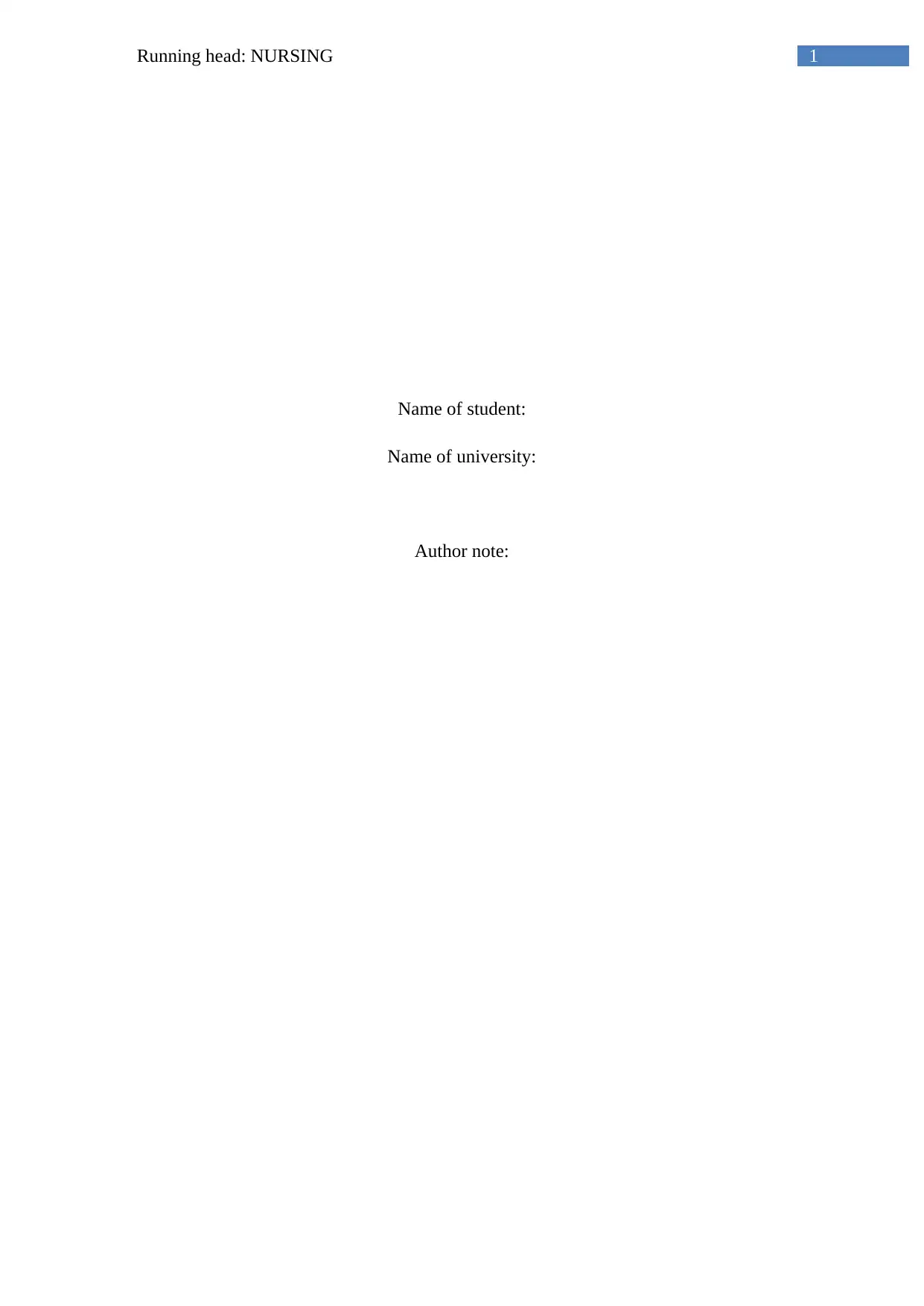
1Running head: NURSING
Name of student:
Name of university:
Author note:
Name of student:
Name of university:
Author note:
Secure Best Marks with AI Grader
Need help grading? Try our AI Grader for instant feedback on your assignments.

2
NURSING
Part A
Answer 1
a. It is necessary to collect Mrs. Walker’s past medical history in order to understand the
health complications she had suffered in the past as this would form the basis of the treatment
plan at present. Further, it is necessary to interact with her family members for understanding
the preferences of the patient and other information such as sleep patterns, allergies and
dietary routine (Ackley et al., 2016).
b. The health assessment process has many steps integrated into it, of which the interview
stage is referred to the conversation taking place between the patient and the care giver with
the purpose of highlighting patient information. The purpose of such interviews is to gain
insight into the present as well as past physical condition of the patient and related
physiological concerns. Based on the information collected from the interview, the care plan
for the patient is to be outlined so that desirable patient outcomes are achieved (Cress, 2015).
c. Assessment tools for older adult patients in a clinical setting are used for carrying out a
comprehensive health assessment. Such tools are specific for highlighting patient concerns
pertaining to impairments, health complaints and comorbidities suffered by older adults
(Boltz et al., 2016). Older patients have higher chances of suffering medical morbidity and
functional decline, both physical and cognitive. Assessment tools address each of these risk
factors through their diverse elements embedded int he tools. For carrying out an assessment
for Mrs. Walker, the two assessment tool that would be appropriate are Patient Health
Questionnaire-9 (PHQ-9) and Katz Index of Independence in Activities of Daily Living.
NURSING
Part A
Answer 1
a. It is necessary to collect Mrs. Walker’s past medical history in order to understand the
health complications she had suffered in the past as this would form the basis of the treatment
plan at present. Further, it is necessary to interact with her family members for understanding
the preferences of the patient and other information such as sleep patterns, allergies and
dietary routine (Ackley et al., 2016).
b. The health assessment process has many steps integrated into it, of which the interview
stage is referred to the conversation taking place between the patient and the care giver with
the purpose of highlighting patient information. The purpose of such interviews is to gain
insight into the present as well as past physical condition of the patient and related
physiological concerns. Based on the information collected from the interview, the care plan
for the patient is to be outlined so that desirable patient outcomes are achieved (Cress, 2015).
c. Assessment tools for older adult patients in a clinical setting are used for carrying out a
comprehensive health assessment. Such tools are specific for highlighting patient concerns
pertaining to impairments, health complaints and comorbidities suffered by older adults
(Boltz et al., 2016). Older patients have higher chances of suffering medical morbidity and
functional decline, both physical and cognitive. Assessment tools address each of these risk
factors through their diverse elements embedded int he tools. For carrying out an assessment
for Mrs. Walker, the two assessment tool that would be appropriate are Patient Health
Questionnaire-9 (PHQ-9) and Katz Index of Independence in Activities of Daily Living.
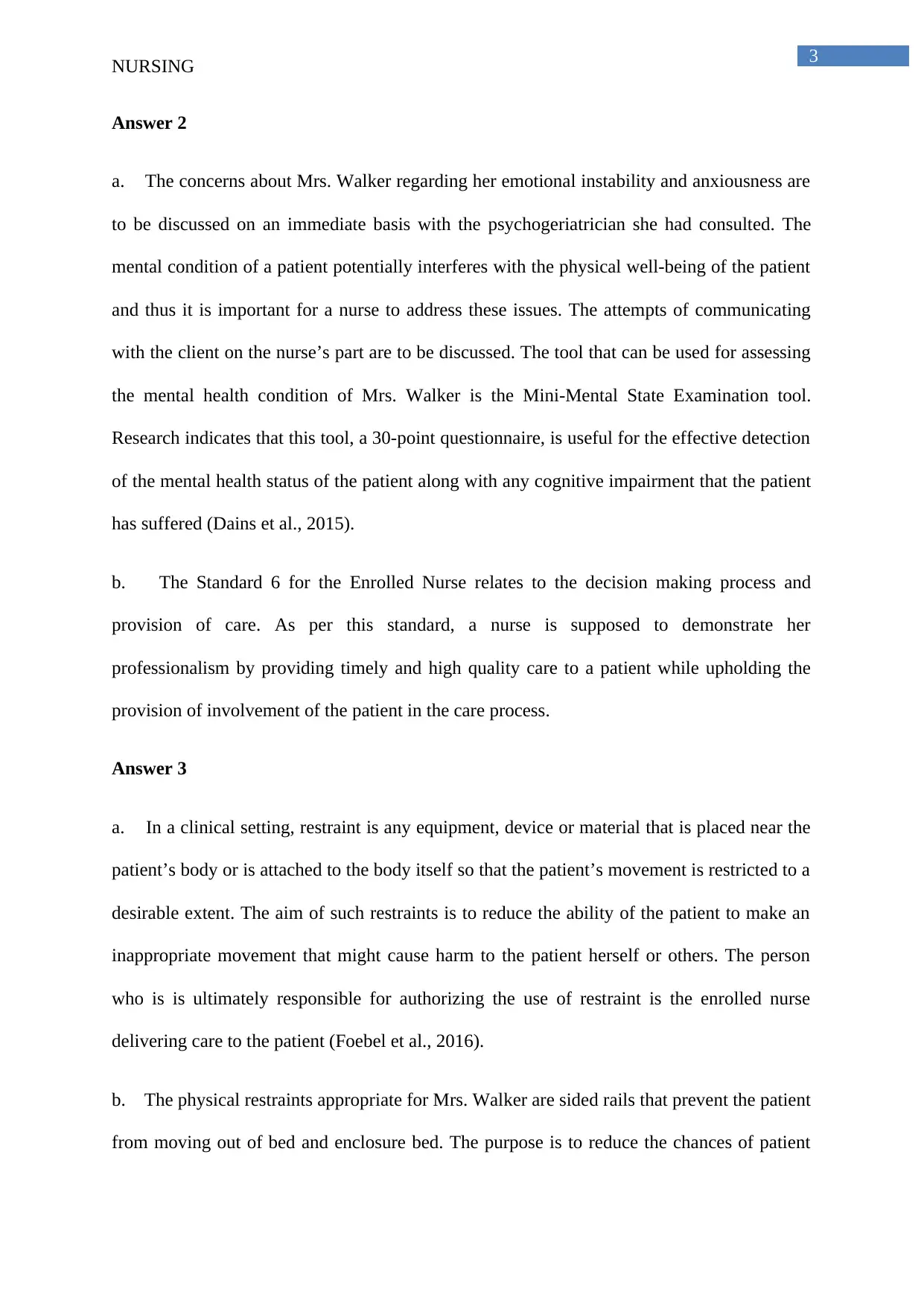
3
NURSING
Answer 2
a. The concerns about Mrs. Walker regarding her emotional instability and anxiousness are
to be discussed on an immediate basis with the psychogeriatrician she had consulted. The
mental condition of a patient potentially interferes with the physical well-being of the patient
and thus it is important for a nurse to address these issues. The attempts of communicating
with the client on the nurse’s part are to be discussed. The tool that can be used for assessing
the mental health condition of Mrs. Walker is the Mini-Mental State Examination tool.
Research indicates that this tool, a 30-point questionnaire, is useful for the effective detection
of the mental health status of the patient along with any cognitive impairment that the patient
has suffered (Dains et al., 2015).
b. The Standard 6 for the Enrolled Nurse relates to the decision making process and
provision of care. As per this standard, a nurse is supposed to demonstrate her
professionalism by providing timely and high quality care to a patient while upholding the
provision of involvement of the patient in the care process.
Answer 3
a. In a clinical setting, restraint is any equipment, device or material that is placed near the
patient’s body or is attached to the body itself so that the patient’s movement is restricted to a
desirable extent. The aim of such restraints is to reduce the ability of the patient to make an
inappropriate movement that might cause harm to the patient herself or others. The person
who is is ultimately responsible for authorizing the use of restraint is the enrolled nurse
delivering care to the patient (Foebel et al., 2016).
b. The physical restraints appropriate for Mrs. Walker are sided rails that prevent the patient
from moving out of bed and enclosure bed. The purpose is to reduce the chances of patient
NURSING
Answer 2
a. The concerns about Mrs. Walker regarding her emotional instability and anxiousness are
to be discussed on an immediate basis with the psychogeriatrician she had consulted. The
mental condition of a patient potentially interferes with the physical well-being of the patient
and thus it is important for a nurse to address these issues. The attempts of communicating
with the client on the nurse’s part are to be discussed. The tool that can be used for assessing
the mental health condition of Mrs. Walker is the Mini-Mental State Examination tool.
Research indicates that this tool, a 30-point questionnaire, is useful for the effective detection
of the mental health status of the patient along with any cognitive impairment that the patient
has suffered (Dains et al., 2015).
b. The Standard 6 for the Enrolled Nurse relates to the decision making process and
provision of care. As per this standard, a nurse is supposed to demonstrate her
professionalism by providing timely and high quality care to a patient while upholding the
provision of involvement of the patient in the care process.
Answer 3
a. In a clinical setting, restraint is any equipment, device or material that is placed near the
patient’s body or is attached to the body itself so that the patient’s movement is restricted to a
desirable extent. The aim of such restraints is to reduce the ability of the patient to make an
inappropriate movement that might cause harm to the patient herself or others. The person
who is is ultimately responsible for authorizing the use of restraint is the enrolled nurse
delivering care to the patient (Foebel et al., 2016).
b. The physical restraints appropriate for Mrs. Walker are sided rails that prevent the patient
from moving out of bed and enclosure bed. The purpose is to reduce the chances of patient
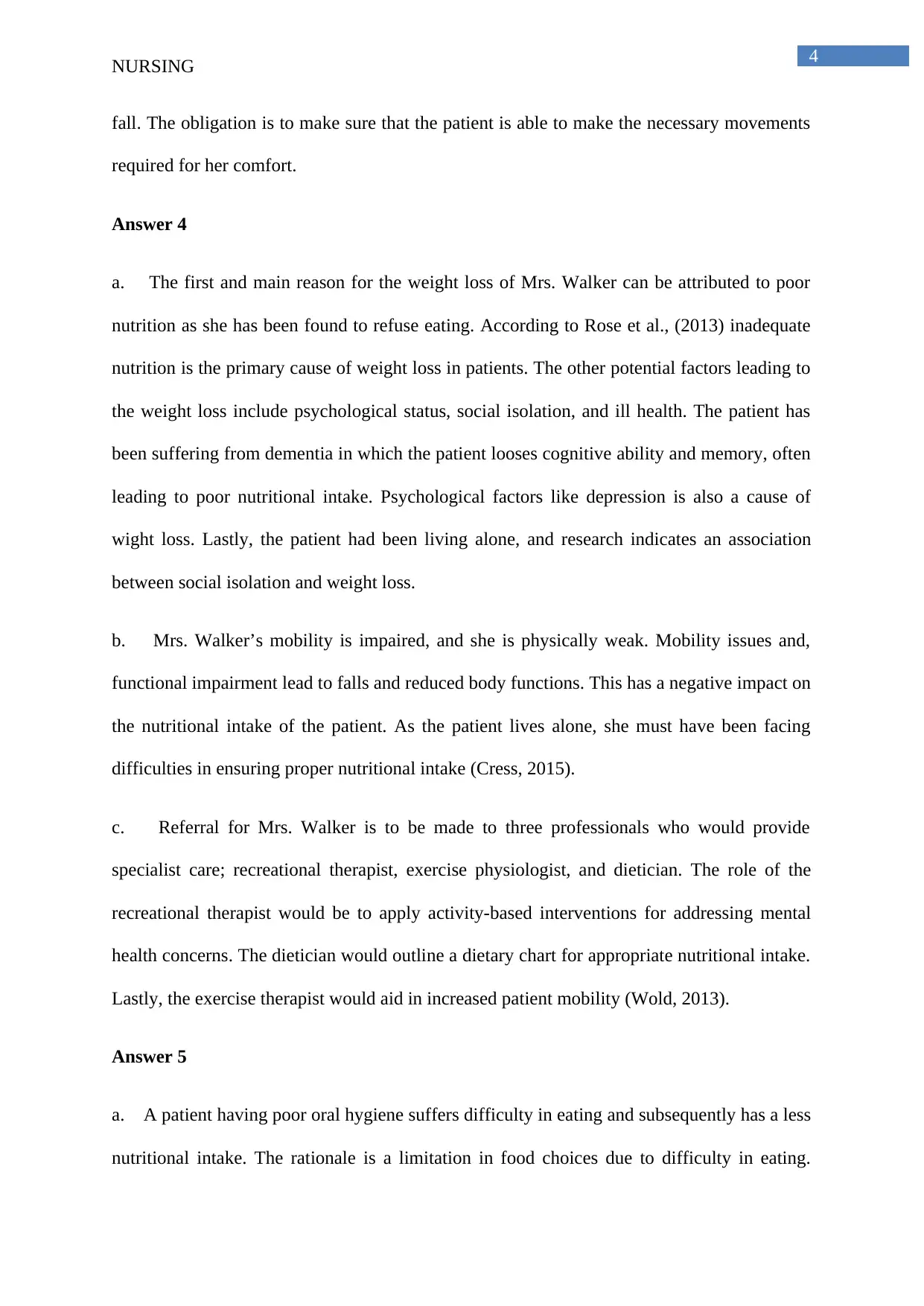
4
NURSING
fall. The obligation is to make sure that the patient is able to make the necessary movements
required for her comfort.
Answer 4
a. The first and main reason for the weight loss of Mrs. Walker can be attributed to poor
nutrition as she has been found to refuse eating. According to Rose et al., (2013) inadequate
nutrition is the primary cause of weight loss in patients. The other potential factors leading to
the weight loss include psychological status, social isolation, and ill health. The patient has
been suffering from dementia in which the patient looses cognitive ability and memory, often
leading to poor nutritional intake. Psychological factors like depression is also a cause of
wight loss. Lastly, the patient had been living alone, and research indicates an association
between social isolation and weight loss.
b. Mrs. Walker’s mobility is impaired, and she is physically weak. Mobility issues and,
functional impairment lead to falls and reduced body functions. This has a negative impact on
the nutritional intake of the patient. As the patient lives alone, she must have been facing
difficulties in ensuring proper nutritional intake (Cress, 2015).
c. Referral for Mrs. Walker is to be made to three professionals who would provide
specialist care; recreational therapist, exercise physiologist, and dietician. The role of the
recreational therapist would be to apply activity-based interventions for addressing mental
health concerns. The dietician would outline a dietary chart for appropriate nutritional intake.
Lastly, the exercise therapist would aid in increased patient mobility (Wold, 2013).
Answer 5
a. A patient having poor oral hygiene suffers difficulty in eating and subsequently has a less
nutritional intake. The rationale is a limitation in food choices due to difficulty in eating.
NURSING
fall. The obligation is to make sure that the patient is able to make the necessary movements
required for her comfort.
Answer 4
a. The first and main reason for the weight loss of Mrs. Walker can be attributed to poor
nutrition as she has been found to refuse eating. According to Rose et al., (2013) inadequate
nutrition is the primary cause of weight loss in patients. The other potential factors leading to
the weight loss include psychological status, social isolation, and ill health. The patient has
been suffering from dementia in which the patient looses cognitive ability and memory, often
leading to poor nutritional intake. Psychological factors like depression is also a cause of
wight loss. Lastly, the patient had been living alone, and research indicates an association
between social isolation and weight loss.
b. Mrs. Walker’s mobility is impaired, and she is physically weak. Mobility issues and,
functional impairment lead to falls and reduced body functions. This has a negative impact on
the nutritional intake of the patient. As the patient lives alone, she must have been facing
difficulties in ensuring proper nutritional intake (Cress, 2015).
c. Referral for Mrs. Walker is to be made to three professionals who would provide
specialist care; recreational therapist, exercise physiologist, and dietician. The role of the
recreational therapist would be to apply activity-based interventions for addressing mental
health concerns. The dietician would outline a dietary chart for appropriate nutritional intake.
Lastly, the exercise therapist would aid in increased patient mobility (Wold, 2013).
Answer 5
a. A patient having poor oral hygiene suffers difficulty in eating and subsequently has a less
nutritional intake. The rationale is a limitation in food choices due to difficulty in eating.
Secure Best Marks with AI Grader
Need help grading? Try our AI Grader for instant feedback on your assignments.
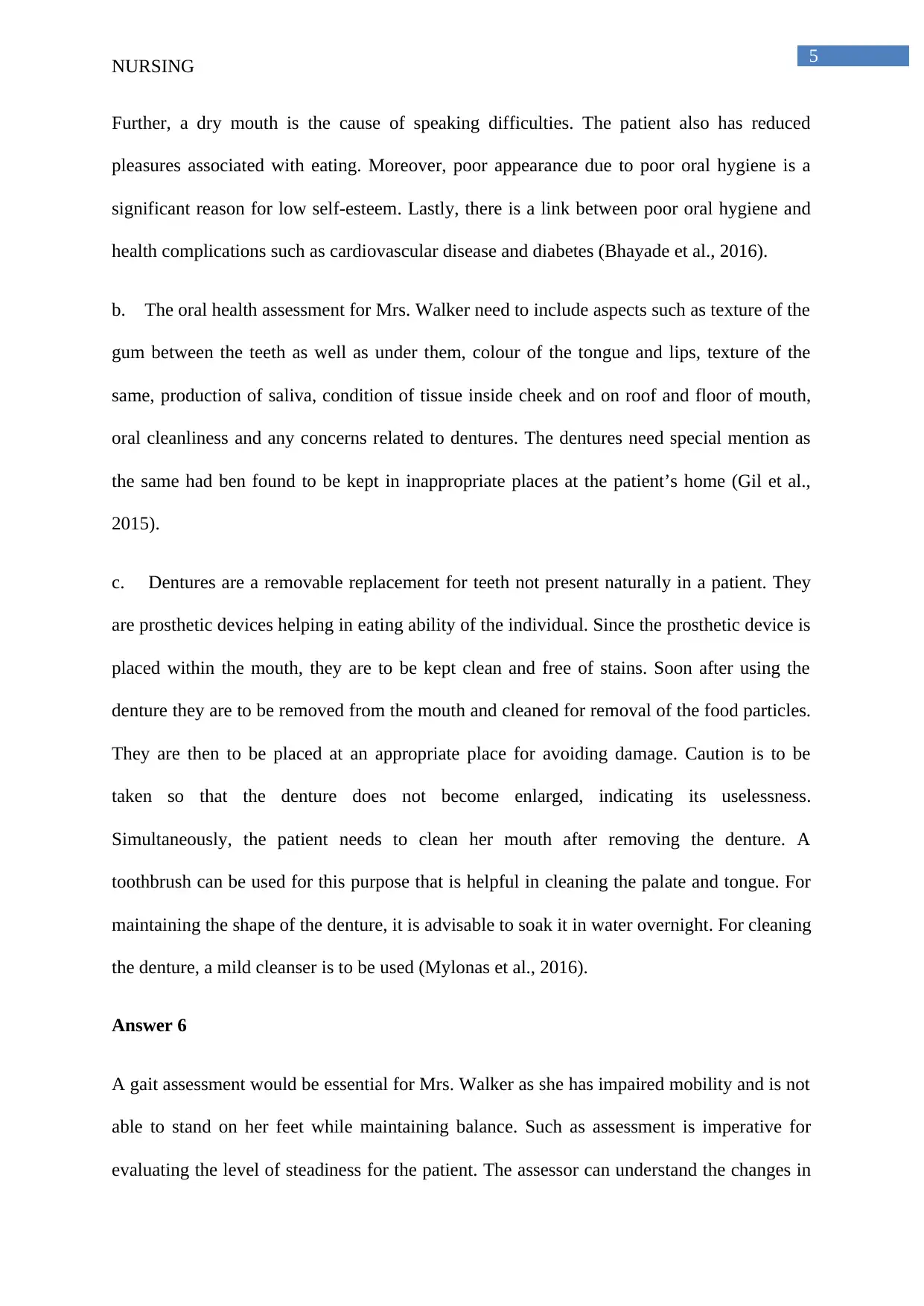
5
NURSING
Further, a dry mouth is the cause of speaking difficulties. The patient also has reduced
pleasures associated with eating. Moreover, poor appearance due to poor oral hygiene is a
significant reason for low self-esteem. Lastly, there is a link between poor oral hygiene and
health complications such as cardiovascular disease and diabetes (Bhayade et al., 2016).
b. The oral health assessment for Mrs. Walker need to include aspects such as texture of the
gum between the teeth as well as under them, colour of the tongue and lips, texture of the
same, production of saliva, condition of tissue inside cheek and on roof and floor of mouth,
oral cleanliness and any concerns related to dentures. The dentures need special mention as
the same had ben found to be kept in inappropriate places at the patient’s home (Gil et al.,
2015).
c. Dentures are a removable replacement for teeth not present naturally in a patient. They
are prosthetic devices helping in eating ability of the individual. Since the prosthetic device is
placed within the mouth, they are to be kept clean and free of stains. Soon after using the
denture they are to be removed from the mouth and cleaned for removal of the food particles.
They are then to be placed at an appropriate place for avoiding damage. Caution is to be
taken so that the denture does not become enlarged, indicating its uselessness.
Simultaneously, the patient needs to clean her mouth after removing the denture. A
toothbrush can be used for this purpose that is helpful in cleaning the palate and tongue. For
maintaining the shape of the denture, it is advisable to soak it in water overnight. For cleaning
the denture, a mild cleanser is to be used (Mylonas et al., 2016).
Answer 6
A gait assessment would be essential for Mrs. Walker as she has impaired mobility and is not
able to stand on her feet while maintaining balance. Such as assessment is imperative for
evaluating the level of steadiness for the patient. The assessor can understand the changes in
NURSING
Further, a dry mouth is the cause of speaking difficulties. The patient also has reduced
pleasures associated with eating. Moreover, poor appearance due to poor oral hygiene is a
significant reason for low self-esteem. Lastly, there is a link between poor oral hygiene and
health complications such as cardiovascular disease and diabetes (Bhayade et al., 2016).
b. The oral health assessment for Mrs. Walker need to include aspects such as texture of the
gum between the teeth as well as under them, colour of the tongue and lips, texture of the
same, production of saliva, condition of tissue inside cheek and on roof and floor of mouth,
oral cleanliness and any concerns related to dentures. The dentures need special mention as
the same had ben found to be kept in inappropriate places at the patient’s home (Gil et al.,
2015).
c. Dentures are a removable replacement for teeth not present naturally in a patient. They
are prosthetic devices helping in eating ability of the individual. Since the prosthetic device is
placed within the mouth, they are to be kept clean and free of stains. Soon after using the
denture they are to be removed from the mouth and cleaned for removal of the food particles.
They are then to be placed at an appropriate place for avoiding damage. Caution is to be
taken so that the denture does not become enlarged, indicating its uselessness.
Simultaneously, the patient needs to clean her mouth after removing the denture. A
toothbrush can be used for this purpose that is helpful in cleaning the palate and tongue. For
maintaining the shape of the denture, it is advisable to soak it in water overnight. For cleaning
the denture, a mild cleanser is to be used (Mylonas et al., 2016).
Answer 6
A gait assessment would be essential for Mrs. Walker as she has impaired mobility and is not
able to stand on her feet while maintaining balance. Such as assessment is imperative for
evaluating the level of steadiness for the patient. The assessor can understand the changes in
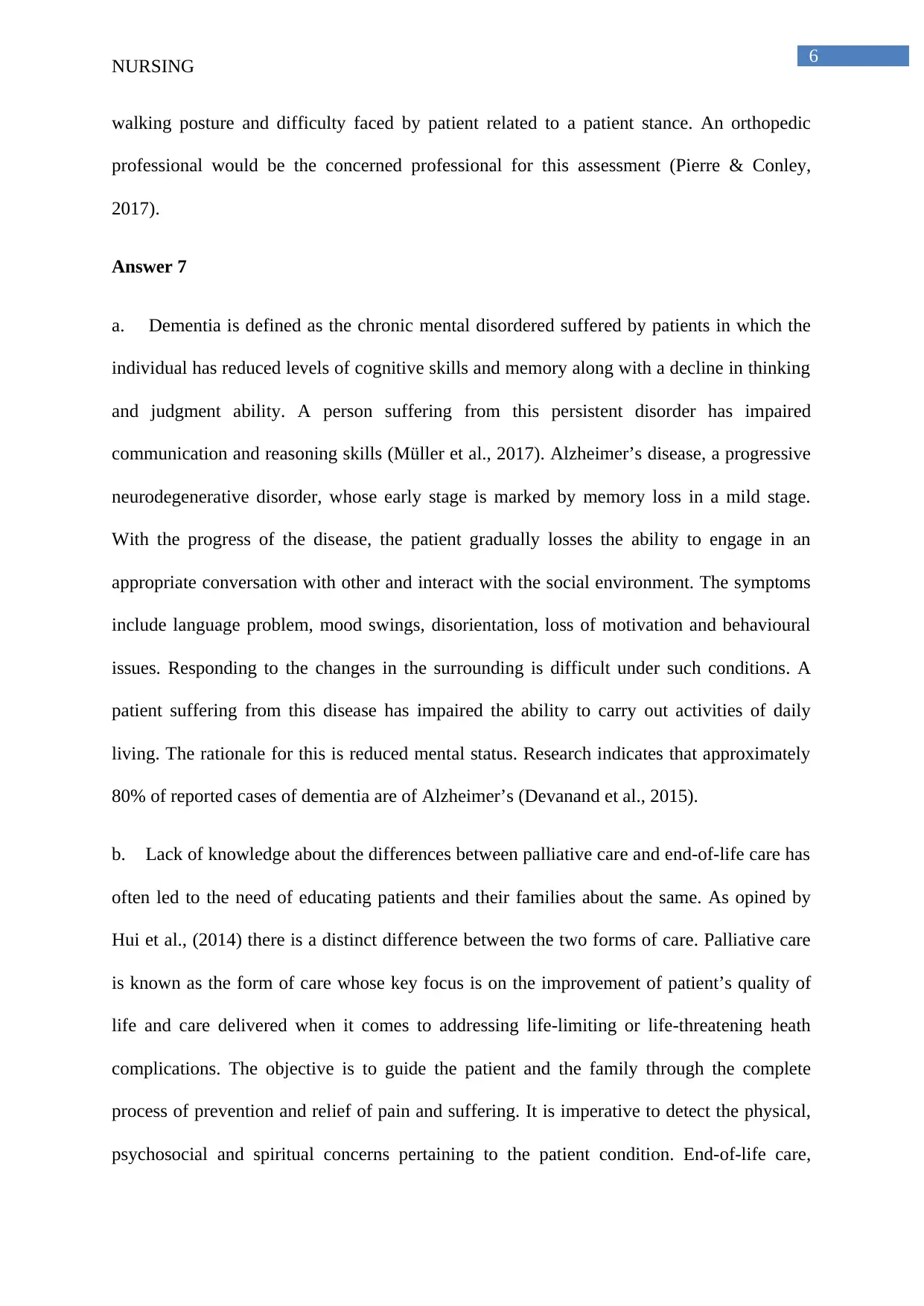
6
NURSING
walking posture and difficulty faced by patient related to a patient stance. An orthopedic
professional would be the concerned professional for this assessment (Pierre & Conley,
2017).
Answer 7
a. Dementia is defined as the chronic mental disordered suffered by patients in which the
individual has reduced levels of cognitive skills and memory along with a decline in thinking
and judgment ability. A person suffering from this persistent disorder has impaired
communication and reasoning skills (Müller et al., 2017). Alzheimer’s disease, a progressive
neurodegenerative disorder, whose early stage is marked by memory loss in a mild stage.
With the progress of the disease, the patient gradually losses the ability to engage in an
appropriate conversation with other and interact with the social environment. The symptoms
include language problem, mood swings, disorientation, loss of motivation and behavioural
issues. Responding to the changes in the surrounding is difficult under such conditions. A
patient suffering from this disease has impaired the ability to carry out activities of daily
living. The rationale for this is reduced mental status. Research indicates that approximately
80% of reported cases of dementia are of Alzheimer’s (Devanand et al., 2015).
b. Lack of knowledge about the differences between palliative care and end-of-life care has
often led to the need of educating patients and their families about the same. As opined by
Hui et al., (2014) there is a distinct difference between the two forms of care. Palliative care
is known as the form of care whose key focus is on the improvement of patient’s quality of
life and care delivered when it comes to addressing life-limiting or life-threatening heath
complications. The objective is to guide the patient and the family through the complete
process of prevention and relief of pain and suffering. It is imperative to detect the physical,
psychosocial and spiritual concerns pertaining to the patient condition. End-of-life care,
NURSING
walking posture and difficulty faced by patient related to a patient stance. An orthopedic
professional would be the concerned professional for this assessment (Pierre & Conley,
2017).
Answer 7
a. Dementia is defined as the chronic mental disordered suffered by patients in which the
individual has reduced levels of cognitive skills and memory along with a decline in thinking
and judgment ability. A person suffering from this persistent disorder has impaired
communication and reasoning skills (Müller et al., 2017). Alzheimer’s disease, a progressive
neurodegenerative disorder, whose early stage is marked by memory loss in a mild stage.
With the progress of the disease, the patient gradually losses the ability to engage in an
appropriate conversation with other and interact with the social environment. The symptoms
include language problem, mood swings, disorientation, loss of motivation and behavioural
issues. Responding to the changes in the surrounding is difficult under such conditions. A
patient suffering from this disease has impaired the ability to carry out activities of daily
living. The rationale for this is reduced mental status. Research indicates that approximately
80% of reported cases of dementia are of Alzheimer’s (Devanand et al., 2015).
b. Lack of knowledge about the differences between palliative care and end-of-life care has
often led to the need of educating patients and their families about the same. As opined by
Hui et al., (2014) there is a distinct difference between the two forms of care. Palliative care
is known as the form of care whose key focus is on the improvement of patient’s quality of
life and care delivered when it comes to addressing life-limiting or life-threatening heath
complications. The objective is to guide the patient and the family through the complete
process of prevention and relief of pain and suffering. It is imperative to detect the physical,
psychosocial and spiritual concerns pertaining to the patient condition. End-of-life care,
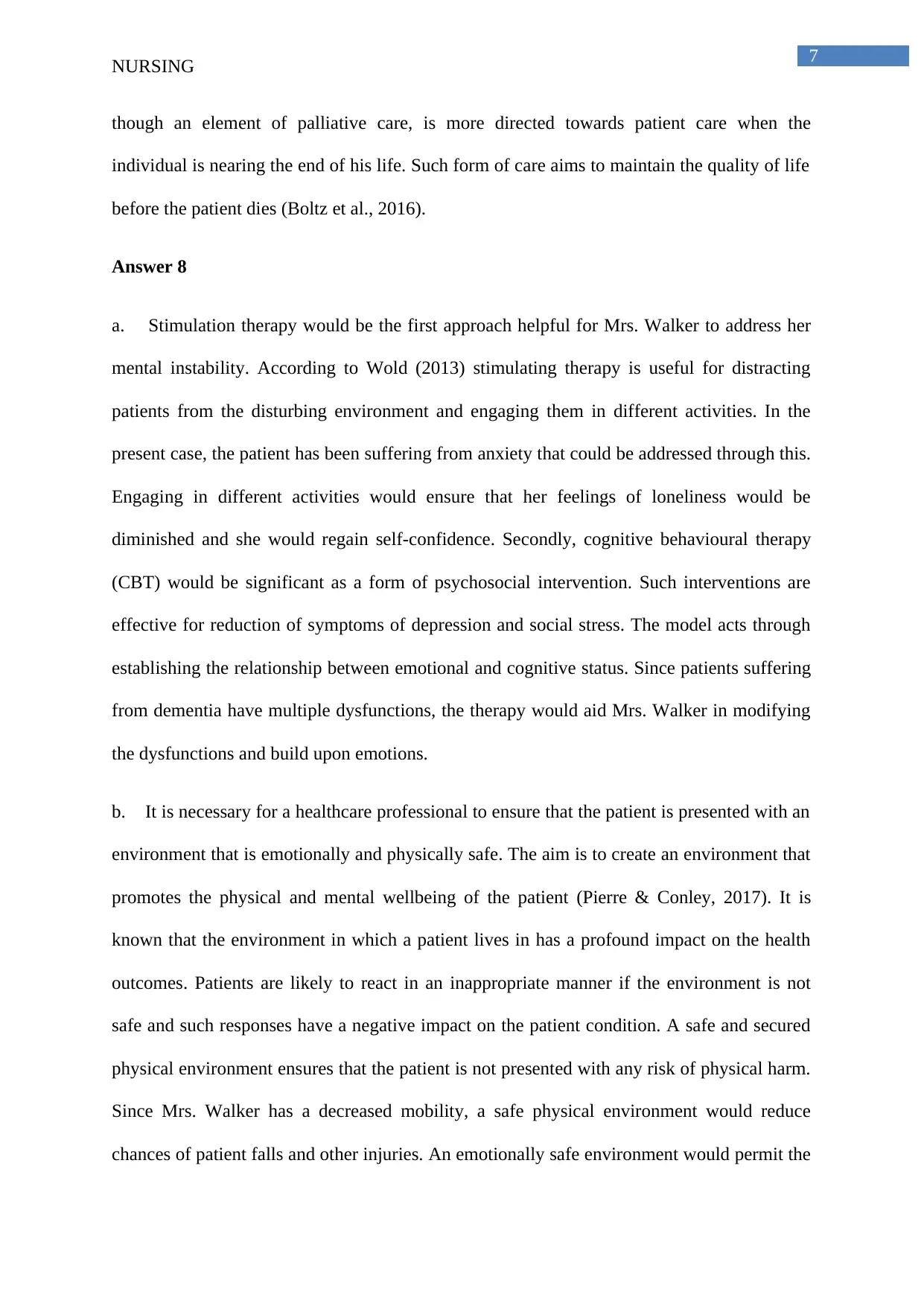
7
NURSING
though an element of palliative care, is more directed towards patient care when the
individual is nearing the end of his life. Such form of care aims to maintain the quality of life
before the patient dies (Boltz et al., 2016).
Answer 8
a. Stimulation therapy would be the first approach helpful for Mrs. Walker to address her
mental instability. According to Wold (2013) stimulating therapy is useful for distracting
patients from the disturbing environment and engaging them in different activities. In the
present case, the patient has been suffering from anxiety that could be addressed through this.
Engaging in different activities would ensure that her feelings of loneliness would be
diminished and she would regain self-confidence. Secondly, cognitive behavioural therapy
(CBT) would be significant as a form of psychosocial intervention. Such interventions are
effective for reduction of symptoms of depression and social stress. The model acts through
establishing the relationship between emotional and cognitive status. Since patients suffering
from dementia have multiple dysfunctions, the therapy would aid Mrs. Walker in modifying
the dysfunctions and build upon emotions.
b. It is necessary for a healthcare professional to ensure that the patient is presented with an
environment that is emotionally and physically safe. The aim is to create an environment that
promotes the physical and mental wellbeing of the patient (Pierre & Conley, 2017). It is
known that the environment in which a patient lives in has a profound impact on the health
outcomes. Patients are likely to react in an inappropriate manner if the environment is not
safe and such responses have a negative impact on the patient condition. A safe and secured
physical environment ensures that the patient is not presented with any risk of physical harm.
Since Mrs. Walker has a decreased mobility, a safe physical environment would reduce
chances of patient falls and other injuries. An emotionally safe environment would permit the
NURSING
though an element of palliative care, is more directed towards patient care when the
individual is nearing the end of his life. Such form of care aims to maintain the quality of life
before the patient dies (Boltz et al., 2016).
Answer 8
a. Stimulation therapy would be the first approach helpful for Mrs. Walker to address her
mental instability. According to Wold (2013) stimulating therapy is useful for distracting
patients from the disturbing environment and engaging them in different activities. In the
present case, the patient has been suffering from anxiety that could be addressed through this.
Engaging in different activities would ensure that her feelings of loneliness would be
diminished and she would regain self-confidence. Secondly, cognitive behavioural therapy
(CBT) would be significant as a form of psychosocial intervention. Such interventions are
effective for reduction of symptoms of depression and social stress. The model acts through
establishing the relationship between emotional and cognitive status. Since patients suffering
from dementia have multiple dysfunctions, the therapy would aid Mrs. Walker in modifying
the dysfunctions and build upon emotions.
b. It is necessary for a healthcare professional to ensure that the patient is presented with an
environment that is emotionally and physically safe. The aim is to create an environment that
promotes the physical and mental wellbeing of the patient (Pierre & Conley, 2017). It is
known that the environment in which a patient lives in has a profound impact on the health
outcomes. Patients are likely to react in an inappropriate manner if the environment is not
safe and such responses have a negative impact on the patient condition. A safe and secured
physical environment ensures that the patient is not presented with any risk of physical harm.
Since Mrs. Walker has a decreased mobility, a safe physical environment would reduce
chances of patient falls and other injuries. An emotionally safe environment would permit the
Paraphrase This Document
Need a fresh take? Get an instant paraphrase of this document with our AI Paraphraser
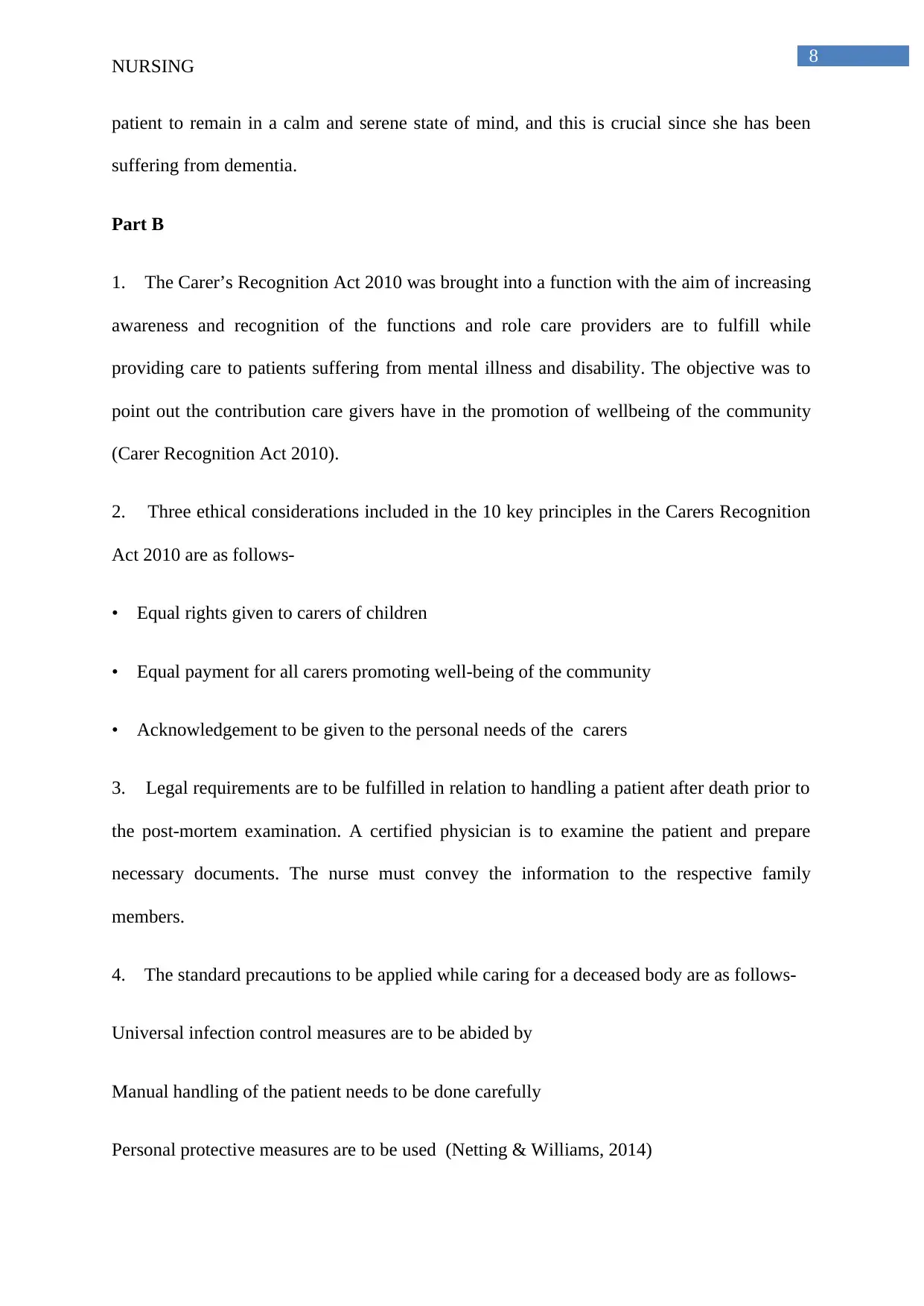
8
NURSING
patient to remain in a calm and serene state of mind, and this is crucial since she has been
suffering from dementia.
Part B
1. The Carer’s Recognition Act 2010 was brought into a function with the aim of increasing
awareness and recognition of the functions and role care providers are to fulfill while
providing care to patients suffering from mental illness and disability. The objective was to
point out the contribution care givers have in the promotion of wellbeing of the community
(Carer Recognition Act 2010).
2. Three ethical considerations included in the 10 key principles in the Carers Recognition
Act 2010 are as follows-
• Equal rights given to carers of children
• Equal payment for all carers promoting well-being of the community
• Acknowledgement to be given to the personal needs of the carers
3. Legal requirements are to be fulfilled in relation to handling a patient after death prior to
the post-mortem examination. A certified physician is to examine the patient and prepare
necessary documents. The nurse must convey the information to the respective family
members.
4. The standard precautions to be applied while caring for a deceased body are as follows-
Universal infection control measures are to be abided by
Manual handling of the patient needs to be done carefully
Personal protective measures are to be used (Netting & Williams, 2014)
NURSING
patient to remain in a calm and serene state of mind, and this is crucial since she has been
suffering from dementia.
Part B
1. The Carer’s Recognition Act 2010 was brought into a function with the aim of increasing
awareness and recognition of the functions and role care providers are to fulfill while
providing care to patients suffering from mental illness and disability. The objective was to
point out the contribution care givers have in the promotion of wellbeing of the community
(Carer Recognition Act 2010).
2. Three ethical considerations included in the 10 key principles in the Carers Recognition
Act 2010 are as follows-
• Equal rights given to carers of children
• Equal payment for all carers promoting well-being of the community
• Acknowledgement to be given to the personal needs of the carers
3. Legal requirements are to be fulfilled in relation to handling a patient after death prior to
the post-mortem examination. A certified physician is to examine the patient and prepare
necessary documents. The nurse must convey the information to the respective family
members.
4. The standard precautions to be applied while caring for a deceased body are as follows-
Universal infection control measures are to be abided by
Manual handling of the patient needs to be done carefully
Personal protective measures are to be used (Netting & Williams, 2014)
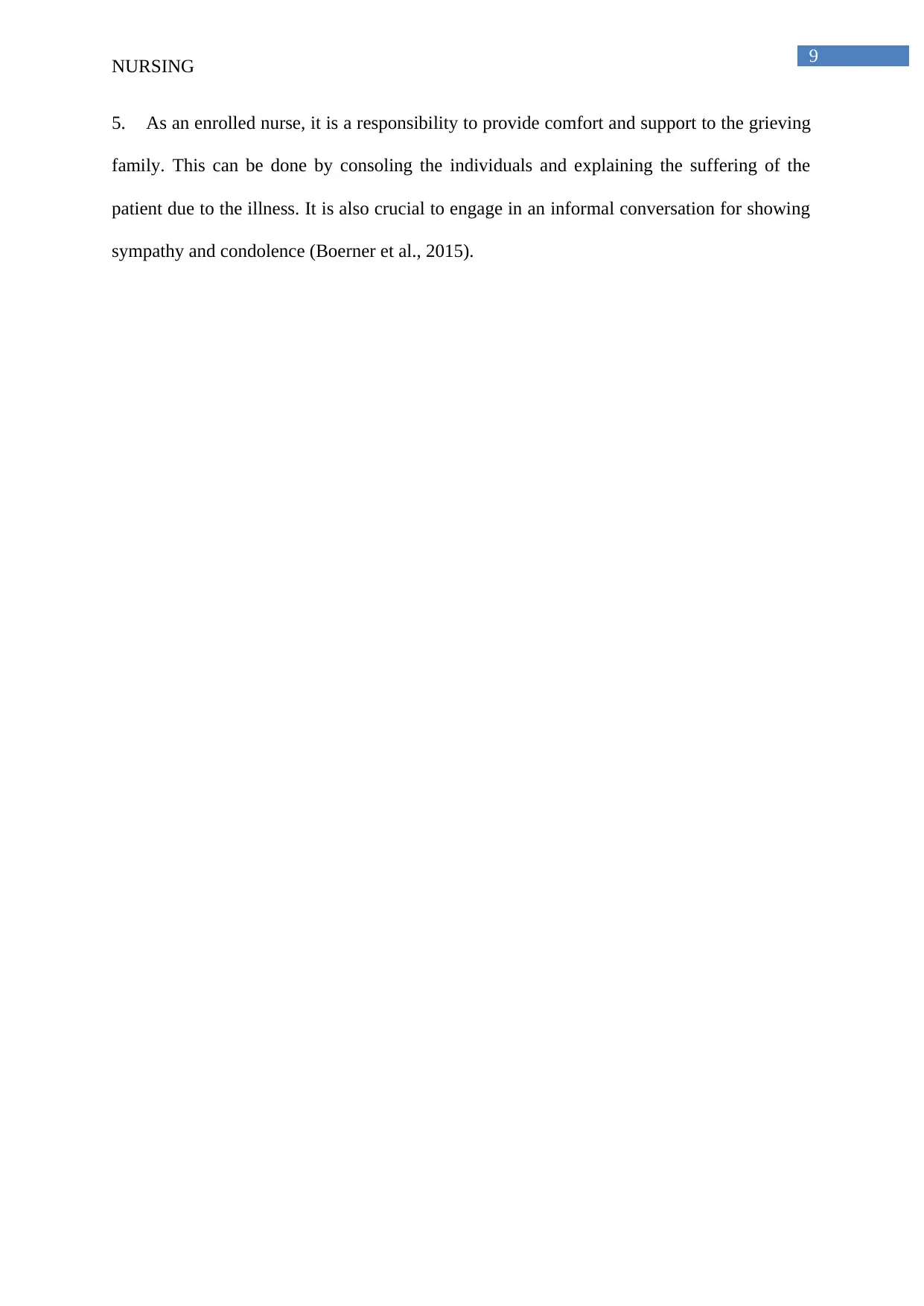
9
NURSING
5. As an enrolled nurse, it is a responsibility to provide comfort and support to the grieving
family. This can be done by consoling the individuals and explaining the suffering of the
patient due to the illness. It is also crucial to engage in an informal conversation for showing
sympathy and condolence (Boerner et al., 2015).
NURSING
5. As an enrolled nurse, it is a responsibility to provide comfort and support to the grieving
family. This can be done by consoling the individuals and explaining the suffering of the
patient due to the illness. It is also crucial to engage in an informal conversation for showing
sympathy and condolence (Boerner et al., 2015).

10
NURSING
References
Ackley, B. J., Ladwig, G. B., & Makic, M. B. F. (2016). Nursing diagnosis handbook: an
evidence-based guide to planning care. Elsevier Health Sciences.
Bhayade, S. S., Mittal, R., Chandak, S., & Bhondey, A. (2016). Assessment of social,
demographic determinants and oral hygiene practices in relation to dental caries
among the children attending Anganwadis of Hingna, Nagpur. Journal of Indian
Society of Pedodontics and Preventive Dentistry, 34(2), 124.
Boerner, K., Burack, O. R., Jopp, D. S., & Mock, S. E. (2015). Grief after patient death:
Direct care staff in nursing homes and homecare. Journal of pain and symptom
management, 49(2), 214-222.
Boltz, M., Capezuti, E., Fulmer, T. T., & Zwicker, D. (Eds.). (2016). Evidence-based
geriatric nursing protocols for best practice. Springer Publishing Company.
Carer Recognition Act 2010 (2017). Retrieved 4 October 2017, from
https://www.dss.gov.au/sites/default/files/documents/05_2016/carer_recognition_act_
2010_guidelines_april_2016.pdf
Cress, C. J. (2015). Handbook of geriatric care management. Jones & Bartlett Publishers.
Dains, J. E., Baumann, L. C., & Scheibel, P. (2015). Advanced Health Assessment & Clinical
Diagnosis in Primary Care. Elsevier Health Sciences.
Devanand, D. P., Lee, S., Manly, J., Andrews, H., Schupf, N., Doty, R. L., ... & Mayeux, R.
(2015). Olfactory deficits predict cognitive decline and Alzheimer dementia in an
urban community. Neurology, 84(2), 182-189.
NURSING
References
Ackley, B. J., Ladwig, G. B., & Makic, M. B. F. (2016). Nursing diagnosis handbook: an
evidence-based guide to planning care. Elsevier Health Sciences.
Bhayade, S. S., Mittal, R., Chandak, S., & Bhondey, A. (2016). Assessment of social,
demographic determinants and oral hygiene practices in relation to dental caries
among the children attending Anganwadis of Hingna, Nagpur. Journal of Indian
Society of Pedodontics and Preventive Dentistry, 34(2), 124.
Boerner, K., Burack, O. R., Jopp, D. S., & Mock, S. E. (2015). Grief after patient death:
Direct care staff in nursing homes and homecare. Journal of pain and symptom
management, 49(2), 214-222.
Boltz, M., Capezuti, E., Fulmer, T. T., & Zwicker, D. (Eds.). (2016). Evidence-based
geriatric nursing protocols for best practice. Springer Publishing Company.
Carer Recognition Act 2010 (2017). Retrieved 4 October 2017, from
https://www.dss.gov.au/sites/default/files/documents/05_2016/carer_recognition_act_
2010_guidelines_april_2016.pdf
Cress, C. J. (2015). Handbook of geriatric care management. Jones & Bartlett Publishers.
Dains, J. E., Baumann, L. C., & Scheibel, P. (2015). Advanced Health Assessment & Clinical
Diagnosis in Primary Care. Elsevier Health Sciences.
Devanand, D. P., Lee, S., Manly, J., Andrews, H., Schupf, N., Doty, R. L., ... & Mayeux, R.
(2015). Olfactory deficits predict cognitive decline and Alzheimer dementia in an
urban community. Neurology, 84(2), 182-189.
Secure Best Marks with AI Grader
Need help grading? Try our AI Grader for instant feedback on your assignments.
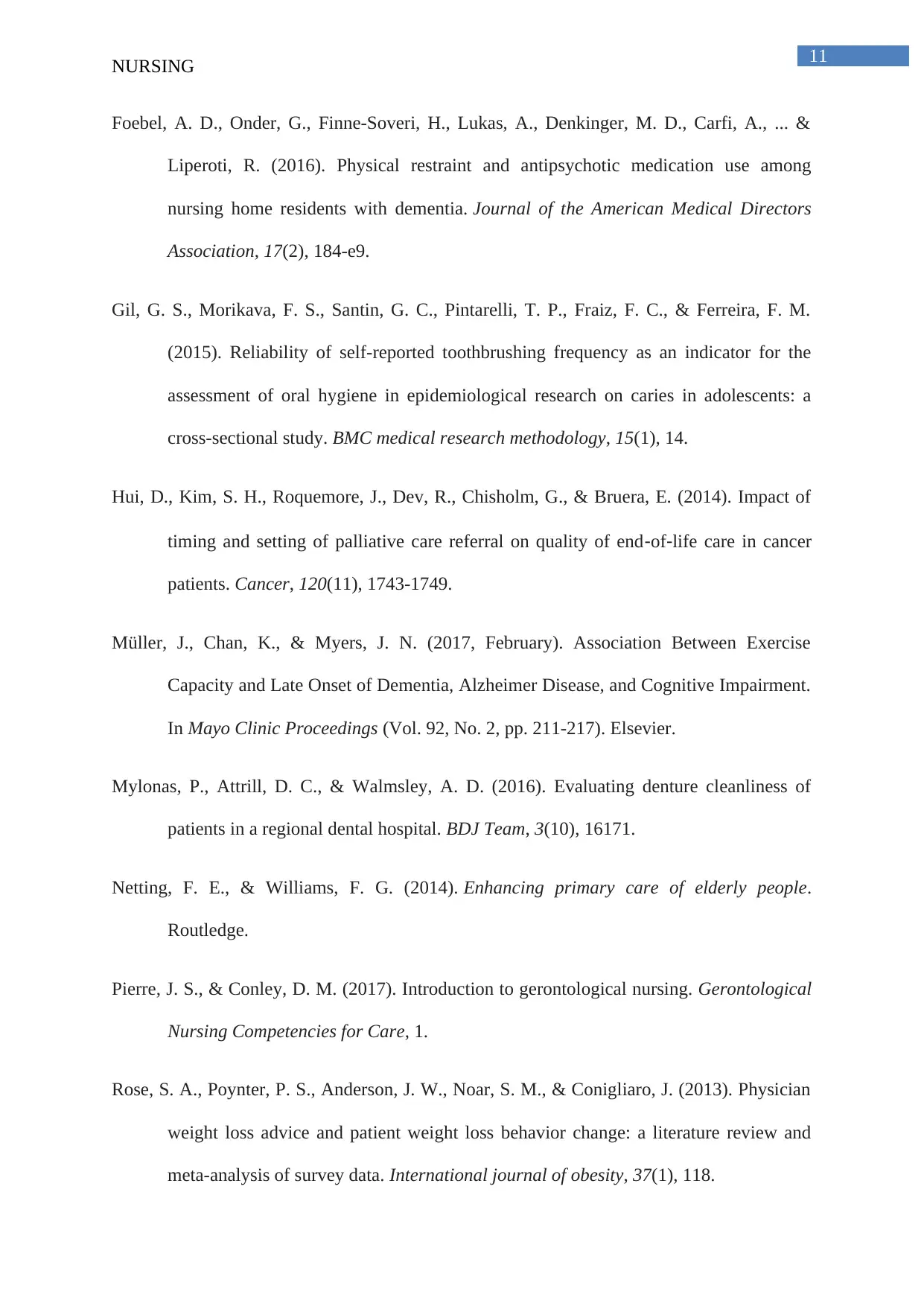
11
NURSING
Foebel, A. D., Onder, G., Finne-Soveri, H., Lukas, A., Denkinger, M. D., Carfi, A., ... &
Liperoti, R. (2016). Physical restraint and antipsychotic medication use among
nursing home residents with dementia. Journal of the American Medical Directors
Association, 17(2), 184-e9.
Gil, G. S., Morikava, F. S., Santin, G. C., Pintarelli, T. P., Fraiz, F. C., & Ferreira, F. M.
(2015). Reliability of self-reported toothbrushing frequency as an indicator for the
assessment of oral hygiene in epidemiological research on caries in adolescents: a
cross-sectional study. BMC medical research methodology, 15(1), 14.
Hui, D., Kim, S. H., Roquemore, J., Dev, R., Chisholm, G., & Bruera, E. (2014). Impact of
timing and setting of palliative care referral on quality of end‐of‐life care in cancer
patients. Cancer, 120(11), 1743-1749.
Müller, J., Chan, K., & Myers, J. N. (2017, February). Association Between Exercise
Capacity and Late Onset of Dementia, Alzheimer Disease, and Cognitive Impairment.
In Mayo Clinic Proceedings (Vol. 92, No. 2, pp. 211-217). Elsevier.
Mylonas, P., Attrill, D. C., & Walmsley, A. D. (2016). Evaluating denture cleanliness of
patients in a regional dental hospital. BDJ Team, 3(10), 16171.
Netting, F. E., & Williams, F. G. (2014). Enhancing primary care of elderly people.
Routledge.
Pierre, J. S., & Conley, D. M. (2017). Introduction to gerontological nursing. Gerontological
Nursing Competencies for Care, 1.
Rose, S. A., Poynter, P. S., Anderson, J. W., Noar, S. M., & Conigliaro, J. (2013). Physician
weight loss advice and patient weight loss behavior change: a literature review and
meta-analysis of survey data. International journal of obesity, 37(1), 118.
NURSING
Foebel, A. D., Onder, G., Finne-Soveri, H., Lukas, A., Denkinger, M. D., Carfi, A., ... &
Liperoti, R. (2016). Physical restraint and antipsychotic medication use among
nursing home residents with dementia. Journal of the American Medical Directors
Association, 17(2), 184-e9.
Gil, G. S., Morikava, F. S., Santin, G. C., Pintarelli, T. P., Fraiz, F. C., & Ferreira, F. M.
(2015). Reliability of self-reported toothbrushing frequency as an indicator for the
assessment of oral hygiene in epidemiological research on caries in adolescents: a
cross-sectional study. BMC medical research methodology, 15(1), 14.
Hui, D., Kim, S. H., Roquemore, J., Dev, R., Chisholm, G., & Bruera, E. (2014). Impact of
timing and setting of palliative care referral on quality of end‐of‐life care in cancer
patients. Cancer, 120(11), 1743-1749.
Müller, J., Chan, K., & Myers, J. N. (2017, February). Association Between Exercise
Capacity and Late Onset of Dementia, Alzheimer Disease, and Cognitive Impairment.
In Mayo Clinic Proceedings (Vol. 92, No. 2, pp. 211-217). Elsevier.
Mylonas, P., Attrill, D. C., & Walmsley, A. D. (2016). Evaluating denture cleanliness of
patients in a regional dental hospital. BDJ Team, 3(10), 16171.
Netting, F. E., & Williams, F. G. (2014). Enhancing primary care of elderly people.
Routledge.
Pierre, J. S., & Conley, D. M. (2017). Introduction to gerontological nursing. Gerontological
Nursing Competencies for Care, 1.
Rose, S. A., Poynter, P. S., Anderson, J. W., Noar, S. M., & Conigliaro, J. (2013). Physician
weight loss advice and patient weight loss behavior change: a literature review and
meta-analysis of survey data. International journal of obesity, 37(1), 118.

12
NURSING
Wold, G. H. (2013). Basic geriatric nursing. Elsevier Health Sciences.
NURSING
Wold, G. H. (2013). Basic geriatric nursing. Elsevier Health Sciences.
1 out of 12
Related Documents
Your All-in-One AI-Powered Toolkit for Academic Success.
+13062052269
info@desklib.com
Available 24*7 on WhatsApp / Email
![[object Object]](/_next/static/media/star-bottom.7253800d.svg)
Unlock your academic potential
© 2024 | Zucol Services PVT LTD | All rights reserved.





